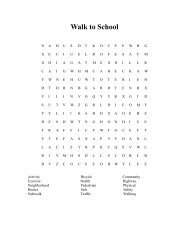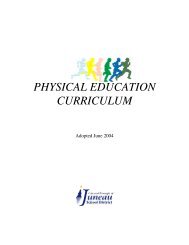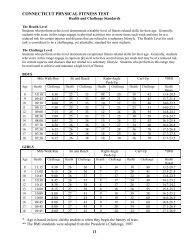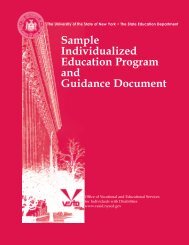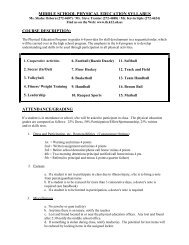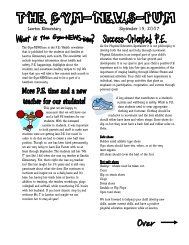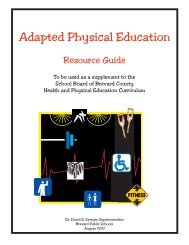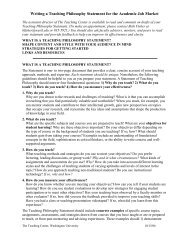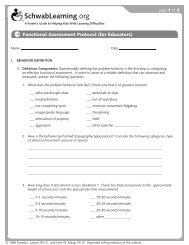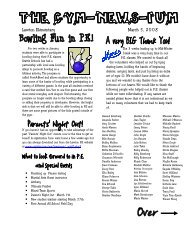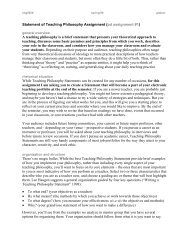Adapted Physical Education Curriculum - thenewPE
Adapted Physical Education Curriculum - thenewPE
Adapted Physical Education Curriculum - thenewPE
- No tags were found...
Create successful ePaper yourself
Turn your PDF publications into a flip-book with our unique Google optimized e-Paper software.
<strong>Adapted</strong> <strong>Physical</strong> <strong>Education</strong> <strong>Curriculum</strong>Wind Gap Middle School<strong>Adapted</strong> <strong>Physical</strong> <strong>Education</strong> Philosophy:One can better understand the philosophy of <strong>Adapted</strong> <strong>Physical</strong> <strong>Education</strong> if we change theword “<strong>Adapted</strong>” to “modified”. Good teaching, which adapts or modifies the curriculum, task,and/or environment so that ALL students can fully participate in physical education. Federal lawmandates that physical education be provided to students with disabilities and defines physicaleducation as the development of physical motor skills, fundamental motor skills and patterns, andskills in aquatics, dance, individual and group games and sports including intramural and lifetimesports. <strong>Adapted</strong> <strong>Physical</strong> <strong>Education</strong> is modifying or changing a physical activity so it is asappropriate for the person with a disability as it is for a person without a disability.Our students will remain in the least restrictive environment for learning. The leastrestrictive environment should be the one in which, students with disabilities are educated alongwith students without disabilities. Modifications can be made for this individual in the areas ofequipment, prompts, cues, actions, and assessment within the regular PE setting. Removal from theregular physical education setting only occurs when the assessment data indicate prescribed goalscannot be met in that setting or if the individual’s medical professional recommends, in writing, thatthe student not participate in physical education to promote healing of illness or injury for morethan a four-week period.Listing every possible disability would be an impossible task. Therefore, when and if anystudent comes to Wind Gap Middle School with a disability not listed below, modifications andadaptations will be made to the curriculum to accommodate the individual.Common Disabilities Defined and Described:Mental Retardation:• Definition: The American Association on Mental Retardation (AAMR, 1992) defines aperson as mentally retarded when the following three criteria are met: cognitive level (IQbelow 70-75), significant limitations exist in two or more adaptive skill areas, and that thecondition is present from childhood (age 18 or less).• Characteristics:Cognitive Learning- area where students differ mostLearning at a slower rateAchieve less academically• Social/Emotional:Frequently exhibit inappropriate responses to social/emotional situationsDo not fully comprehend what is expected of them
• <strong>Physical</strong>/Motor:Delayed development of physical skillsUsually overweight because of less activity levels• Teaching Strategies for Individuals with mild retardation:Place student in less demanding sport positionOver teach the cognitive informationEmphasize fitness activities• Teaching Strategies for Individuals with severe retardation:Emphasize range of motion exercisesHave the individual propel himself as much as possibleConcentrate on correcting posture and body alignmentUse resistance training with therabandsAttention Deficit Hyperactivity Disorder (ADHD):• Definition: A condition that describes students who display hyperactive behaviors, havedifficulty attending to the task at hand, and tend to be impulsive.• Characteristics:Inattentive, poor listening skills and restlessnessImpulsiveHyperactiveOnset before age 7Inappropriate excessive motor activity• Teaching Strategies:Highly structure the environmentReduce teaching spaceControl extraneous stimuliLarger number of activities, shorter time on eachPositive Behavior Modification programsBrief instructionsAutism:• Definition: Classic autism is defined as a developmental disability significantly affectingverbal and nonverbal communication and social interaction; generally evident before age 3.• Characteristics:Impairment in social interactionImpairment of verbal and nonverbal communicationRestricted, repetitive, and stereotypical patterns of behavior, interests & activitiesImpaired imitationLack of awareness of the existence of feelings of othersAbsence of imaginative activity
• Teaching Strategies:Use a consistent behavior modification programTeach in a less stimulating areaUse established routine with repetitive transition strategiesUse a predictable routineBe consistent in use of terms, equipment and class organizationUse vigorous aerobic exercise to reduce self-stimulating behaviorBehavior Disorders:• Definition: A condition of disruptive or inappropriate behaviors that interferes with astudent’s learning, relationships with others, or personal satisfaction to such a degree thatintervention is required.• Characteristics:Poor coordinationRefusal to practiceLoss of emotional controlHostilityNon-cooperative BehaviorDisorientation in space and timeDestructive• Teaching Strategies:Remove distracting objectsImpose limits on use of equipment and facilitiesUse games of social interactionExpect aggressiveness and monitor it closelyUse activities that provide immediate feedbackCerebral Palsy:• Definition: A disorder of movement and posture caused by a defect in the developing brain.• Characteristics:Primitive reflexes are evidentSlow to develop postural reflexesMay have any of the following:Mental retardationConvulsionsSpeech ProblemsOculomotor defectsHearing and vision loss
• Teaching Strategies:Work on muscular flexibilityDevelop range of motionDevelop postural alignmentsUse ramp climbingWork on gait trainingVisual Impairments:• Definition: An overall term that includes all levels of vision loss, from partially sighted tocomplete blindness.• Characteristics:<strong>Physical</strong> fitness levels are below those of sighted peersBalance development is impairedFundamental motor patterns and skills are delayed<strong>Physical</strong> growth and maturation may be delayedWide variation in residual vision• Teaching Strategies:Use other sensory modalities for providing informationUse games for social developmentUse a beeper or other constant sound sourcePlace students where they can best hear instructionsUse contrast between figure and backgroundIncrease or decrease the grade to indicate boundariesBegin new games in slower motionHearing Impairments:• Definition: An overall term that includes all levels of hearing loss, both deaf and hard ofhearing.• Characteristics:Balance may be affectedInformation processing time is longerLower levels of physical fitnessDelay in social/emotional developmentSpeech can range from intelligible to none• Teaching Strategies:Make sure student can see your lips when you speakUse visual demonstrationsCoordinate your communication method with other teachersLearn basic signs and use themUse captioned videotapesStand still when giving instructions
Learning Disabilities:• Definition: A disability in which the individual possesses average intelligence but issubstantially delayed in academic achievement.• Characteristics:Poor spatial orientationClumsinessFigure-background problemsRhythmic problemsBody awareness problemsDifficulty with motor proficiency• Teaching Strategies:Use games, mirrors and tactile activities to help body/space problemsWork on balanceWork on upper and lower body coordination for motor proficiencyUse brightly colored objects for contrastGive opportunity for rhythmical practice
<strong>Adapted</strong> <strong>Physical</strong> <strong>Education</strong> Units:The individual that participates in an <strong>Adapted</strong> <strong>Physical</strong> <strong>Education</strong>al class will be educated in all theregular physical education units that their medical professional will allow or those in which theeducational objectives can be met with success. There will be some additional units that the<strong>Adapted</strong> <strong>Physical</strong> <strong>Education</strong> student will have the opportunity to participate in that the regularphysical education student does not, simply because the class is generally smaller in size. Theseunits consist of the following activities:Aerobic Conditioning, Basketball, Bowling, Dance & Rhythmical Movement, Flexibility &Balance, Field Hockey, Floor Hockey, Fitness, Football, Golf, Lacrosse, Officiating,Recreational Games, Soccer, Softball, Sport History, Track & Field, Tennis, Volleyball andWeight Training.National <strong>Physical</strong> <strong>Education</strong> Standards:1. Demonstrates competency in many movement forms and proficiency in a few movementforms.2. Applies movement concepts and principles to the learning and development of motor skills.3. Exhibits a physically active lifestyle.4. Achieves and maintains a health-enhancing level of physical fitness.5. Demonstrates responsible personal and social behavior in physical activity settings.6. Demonstrates understanding and respect for differences among people in physical activitysettings.7. Understands that physical activity provides opportunities for enjoyment, challenge, selfexpression,and social integration.Pennsylvania <strong>Physical</strong> <strong>Education</strong> Standards:10.3 Safety and Injury PreventionA. Safe/Unsafe PracticesB. Emergency Responses/Injury ManagementC. Strategies to Avoid/Manage ConflictD. Safe Practices in <strong>Physical</strong> Activity10.4 <strong>Physical</strong> ActivityA. <strong>Physical</strong> Activities that Promote Health and FitnessB. Effects of Regular ParticipationC. Responses of the Body Systems to <strong>Physical</strong> ActivityD. <strong>Physical</strong> Activity PreferencesE. <strong>Physical</strong> Activity and Motor Skill ImprovementF. <strong>Physical</strong> Activity and Group Interaction10.5 Concepts, Principles and Strategies of MovementA. Movement Skills and ConceptsB. Motor Skill DevelopmentC. Practice StrategiesD. Principles of Exercise/TrainingE. Scientific Principles that Affect MovementF. Game Strategies
General Modifications that can be used in most Units:Equipment:Larger/lighterUse of VelcroLarger goal/targetMark Positions on playing fieldLower goal/targetScoops for catchingVary balls (size, weight, color, texture)Boundary/Playing field:Decrease size/distanceUse well-defined boundariesSimplify patternsRemove obstaclesTime:Vary the tempoSlow the pace of activityLengthen the timeShorten the timeProvide frequent rest periodsRules, Prompts, & Cues:Demonstrate/model activityPartner assistedDisregard time limitsOral promptsProvide more space between studentsEliminate outs/strike-outsAllow ball to remain stationaryAllow batter to sit in chairPlace students with disability near teacherActions:Change locomotor patternsModify graspsModify body positionsReduce number of actionsUse different body parts
• Push/pull: Develop and maintain pushing and pulling skills for practical & recreationalpurposes.-Tug-o-war-Bowl-Weight machines-Shot put-Open doors-Wheelchairs-Pull-ups-Push-ups• Twist/Turn: Develop & maintain ability to twist/turn body for practical & recreationalpurposes.-Calisthenics-Tumbling-Trunk twists for striking or practical purposesBalance:• Static Balance: Use static balance for practical and recreational purposes-Balance beam-One foot stands-Calisthenics-Stand after kick• Dynamic or Moving Balance: Maintain balance while in motion for practical and recreationalpurposes-Walk on various surfaces and terrain-Hike-Climb stairsEye-hand Coordination:• Catch: Catch during drill & practice activities-Hand dribble-Trap-One or two hand catch when rolled-One or two hand catch when bounced-One or two hand catch when tossed-One or two hand catch when thrown• Strike: Use striking skills for practical & recreational purposes.-Striking games-Striking a variety of objects with hands-Use a variety of implements for striking skills• Throw: Throw objects in drills, activities, and games-Throw a variety of objects-Toss a variety of objects-Pass a variety of objects-Use a variety of targets, distance and degree of complexity
Eye-foot Coordination:• Kick: Use kicking motion for practical and recreational purposes-Kick a stationary object-Kick a rolled object-Punt-Skill drills with various distances, speeds & configurations-Vary ball size for games and sport• Coordinated foot movement: Use coordinate foot movements for practical and rhythmicactivities-Foot dribble-Paces-Rhythmic movement (skip, jump rope, march, dance, climb stairs)-Walk alone in a crowdGeneral Coordination:• Climb structures and apparatus: Climb structures and apparatus with the environment-Transitioning-Climb into vehicles, (car, bus, etc)-Climb into furniture-Climb into playground equipment• Agility: Display agility into sports-related skills-Transitional games & sports-Dodge, chase & flee-Pivot-Change direction-Stop• Jump Rope: Jump rope for fitness and recreation-Jump while having rope turned by others-Jump while self-turning rope-Jump in place-Jump continuously-Rhythmic jump-GamesCreative Movement:• Movement Exploration: Explore movement possibilities-Different types of throws-Cross climb apparatus-Vary speed, positions & direction-Use a variety of apparatus objects• Move to Music: Move to music for personal and social enjoyment-Dance-Vary tempo, speed, type, style & volume-Aerobic exercise
Cooperation:• Turn taking: Take turns in group & team situations-Take turns in a line while maintaining line position-Skill drills-Rotate & switch positions• Sportsmanship: Demonstrate sportsmanship skills and attitudes.-Use positive statements and support-Peer pressure situations-Follow rules and adult directives-Conflict situationsPersonal Fitness:• Cardiovascular Endurance: Develop and maintain cardiovascular fitness-Aerobic endurance-Distance for time-Time for distance-Sustained run or jog- Use of aerobic equipment• Strength: Develop and maintain strength for practical and recreational purposes-Isometric/isotonic exercises-Weight Training-Use adaptive equipment-Sit-ups-Pull-ups-Push-ups• Flexibility: Develop and maintain flexibility for practical, recreation & injury prevention.-Stretching exercises for various parts of the body-Static self-stretch-Manual stretch-Games-Yoga & Palates• Body Fat: Develop and maintain a healthy percentage of body fat.-BMI Body Mass Index-Height & Weight Charts-Awareness of basic fitness conceptsRespect:• Respect for Others: Show respect for others within group activities regardless of age, gender,ethnicity, and body type or skill level.-Positive feedback-Compliments-Cooperative games-Give and take assistance
• Self Respect: Show self respect within group activities regardless of own ethnicity, gender,body type, or skill level.-Maintain dignity-Active roll within group setting-Socially acceptable conduct-React to social cues-Imitate appropriate behavior of othersUnifying Ideas of <strong>Physical</strong> <strong>Education</strong>:The following are examples of bridges between the unifying ideas of the core curriculum and thefour environments that can be adapted to meet student needs:• Movement Skills and Movement KnowledgeCommunity-Bend arms to push own wheelchair-Be able to maneuver in a crowdRecreation and Leisure-Participate in team activities-Listen to own coach-Do what is instructedDomestic-Make a bed-Perform personal care actionVocational-Pick up items from floor before cleaning-Reach while pulling or pushing a vacuum• Self-image, Self-esteem, and Self realizationCommunity-Walk next to peer or another person-Maintain balance of exercise throughout the dayRecreation and Leisure-Learn or perfect a game-Make supportive gestures to a peer during playDomestic-Talk to peer within acceptable distance-Maneuver around objects without touching themVocational-Develop stamina to complete a work activity-Follow through activity after directions are given• Social Development and InteractionCommunity-Demonstrate appropriate behavior during games-Participate in conflict resolution
Recreation and Leisure-Participate in choosing team positions-Wheel a friend around the basesDomestic-Participate with others in a project-Cooperate in work with a peerVocational-Develop score keeping skills-Participate as a team manager
Subject Area: <strong>Adapted</strong> <strong>Physical</strong> <strong>Education</strong>Unit: Aerobic Conditionng & FitnessUnit Outcomes: The student will be able to identify several types of aerobic activities andparticipate in a few types while keeping track of their progressEssential Outcome and Related Standards:A. Students will learn how to monitor pulse rate and BMI and keep record of their own progress.State Standard(s):10.5DB. Students will participate in various aerobic conditioning activities such as fitness walking,jogging, and following aerobic movements from popular fitness CD's and games.State Standard(s): 10.4 A-EContent and Instructional Activities:A. Students will take and record their own pulse rates using heart rate monitors.Assessment Criteria: Taking and recording heart ratesResources and Materials:• Heart rate monitors & Body Fat Analyzer• Fitness Equipment such as bikes, elliptical trainers, interactive fitness gamesB. Students will participate in fitness walking and/or jogging while being timed for a twenty minuteperiod and various fitness tapes and programs.Assessment Criteria:• Distance covered during timed intervals• Pulse rates generated by activities• Reaching Target heart rate.Possible Modifications:• Frequent rest periods or short breaks• Students can perform just upper body movements where applicable• Students can perform just lower body movements where applicable
Resources and Materials:• Cooper's Aerobic Conditioning Charts• "Fitness Gram" charts• Computer• Computer data materials• Hand helds for recording data• Pedometers• Stop watch• Tae-Bo fitness vidoetapes• Sony Playstation 2 Game set and Eye Cam• Interactive Game CD's: Dance, Dance Revolution & Eye Toy
Subject Area: <strong>Adapted</strong> <strong>Physical</strong> <strong>Education</strong>Unit: BasketballUnit Outcomes: Students will be able to participate in basketball skills and use those skills in amodified game situation.Essential Outcome and Related Standards:A. Students will demonstrate how to safely shoot a basketball.State Standard(s): 10.3D; 10.4 E & F; 10.5 CB. Students will play a modified basketball game with each other.State Standard(s): 10.5 E & FContent and Instructional Activities:A. Students will learn and practice modified ball handling skills such as dribbling, passing, &shooting.Possible Modifications:• Allow traveling• Partner assisted• Oral prompts• Allow two handed dribbling• If student used a wheelchair, allow him to hold ball on lap while moving around• Use beeper ball, and radio under basket for individual with visual impairmentsAssessment Criteria:• Self evaluation of form• Effort & Participation gradeResources and Materials:• Video camcorder & TV for replay• Basketballs of various size and weight• Various sized targets & hoopsB. Students will participate in a modified basketball game according to their own physicalcapabilities.Assessment Criteria:• Score of game• Effort & Participation grade
Resources and Materials:• Various balls (vary size & weight)• Choose the target students were most successful with for game situation• Modify court size and rules
Subject Area: <strong>Adapted</strong> <strong>Physical</strong> <strong>Education</strong>Unit: BowlingUnit Outcomes: Students will be able to participate in a game of bowling and score theirprogressEssential Outcome and Related Standards:A. Students will demonstrate how to safely roll a bowling ball towards the pins.State Standard(s): 10.3D; 10.4F & 10.5AB. Students will score their own game of bowlingState Standard(s): 10.5 E & FContent and Instructional Activities:A. Students will learn and practice bowling balls of different size and weight from variousdistances to knock down pins.Assessment Criteria:• Self evaluation of distance• Effort & Participation gradeResources and Materials:• Bowling balls of various size and weight• Various sized targetsB. Students will participate and score themselves in a modified game of bowling according to theirown physical capabilities.Possible Modifications:• Simplify or reduce number of steps or remain in stationary position• Use two hands instead of one• Use a ramp• Use a partner• Give continuous verbal cluesAssessment Criteria:• Score at end of game• Effort & Participation grade• Self-evaluation log
Resources and Materials:• Various bowling balls (vary size & weight)• Choose the target students were most successful with for game situation• Modify alley length and rules• Allow students to help each other calculate score or use calculators
Subject Area: <strong>Adapted</strong> <strong>Physical</strong> <strong>Education</strong>Unit: Dance & Rhythmical MovementUnit Outcomes: Students will be able to participate in various forms of movement patterns anddance for personal fitness and social enjoyment.Essential Outcome and Related Standards:A. Students will learn and demonstrate to the best of their ability several locomotive patterns.State Standard(s): 10.4 A & E, 10.5EB. Students will practice and perform several popular social, cultural and/or line dances.State Standard(s): 10.4 A and 10.5 BContent and Instructional Activities:A. Students will learn and practice as many of the following basic locomotive patterns as theyare physically able to. Locomotion patterns practiced will be to walk, run, hop, jump, leap,skip, slide and gallop.Assessment Criteria:• Self evaluation• Teacher feedback• Effort & Participation gradeResources and Materials:• Music and player (CD or tape)• Visual chartsB. Students will learn and practice the basic steps, positions and formations of a popular line dance,social and cultural dance.Assessment Criteria:• Effort & Participation grade• Self-evaluationResources and Materials:• Visual cue cards• Music and player (CD or tape)
Possible Modifications:• Slow the pace of sequential progression• Slow tempo• Learn only a short locomotive pattern at one time• Walk through demonstration• Allow more time
Subject Area: <strong>Adapted</strong> <strong>Physical</strong> <strong>Education</strong>Unit: Flexibility & BalanceUnit Outcomes: Students will be able to improve personal flexibility of their overall body andimprove their balanceEssential Outcome and Related Standards:A. Students will learn and demonstrate to the best of their ability several muscular stretches toincrease flexibility of major muscle groups.State Standard(s): 10.4 A & B, 10.5 DB. Students will practice and perform to the best of their ability several static balancemovements.State Standard(s): 10.4 B and 10.5 EContent and Instructional Activities:A. Students will stretch as many of the following major muscle groups as they are physical ableto do. The major muscle groups include head & neck, arms & shoulders, chest & upperback, abdominal & lower back; hips & legsAssessment Criteria:• Pre-test & post testing measurements• Effort & Participation gradeResources and Materials:• Exercise charts• Folding mat• Measuring tape and sit-n-reach measuring tableB. Students will learn and practice the holding several static balance positions successfullywhile practicing walking on a low balance beam & buddy walkers, and sitting and balancingon a large exercise ball.Assessment Criteria:• Effort & Participation grade• Self-evaluationResources and Materials:• Balance balls• Buddy walkers• Low balance beam
Possible Modifications:• Allow more practice time• Partner assisted• Visual and verbal cues
Possible Modifications:• Vary size of goal/target• Shorter distance to goal from shot• Larger puck or indoor ball• Curved stick if necessary• Vary grip if necessary• Longer practice time• Smaller court size for game situations
Subject Area: <strong>Adapted</strong> <strong>Physical</strong> <strong>Education</strong>Unit: FitnessUnit Outcomes: Students will be able to demonstrate knowledge of the components of fitnessand how it relates to their lifestyles.Essential Outcome and Related Standards:A. Students will demonstrate and measure their personal fitness levels not previously tested inthe aerobic conditioning & flexibility units. These fitness tests will measure speed andmuscular strength and endurance.State Standard(s): 10.4 A & C; 10.5 DB. Students will choose and practice various training methods to improve their personal fitnesslevels.State Standard(s): 10.4 B, C, & DContent and Instructional Activities:A. Students will be able increase their cardiovascular fitness and muscular endurance byworking up to a twenty-minute participation period while riding a stationary bike, using theelliptical trainer, or participating in the Dance, Dance Revolution program and/or Eye toygames.Assessment Criteria:• Fit gram Pre & post testsResources and Materials:• Appropriate Fitness Equipment (bikes, elliptical trainers, Sony Playstation 2 programs andgames.• “Fitness gram” program• Internet access for recording progress and logging it into PE Central using handheld computersB. Students will improve their muscular strength and endurance by doing various calisthenicsfor the upper body, lower body and abdominal muscle groups.Assessment Criteria:• Effort & Participation grade• Pre & Post tests
Resources and Materials:• Fitness gram tests & program• Hand held computers & Internet access for logging progress into PE Central• Folding mat• Therabands or resistance bands• Small weights• Hand held computers and Internet accessPossible Modifications:••••Modify exercisesUse therabands/resistance bands while working up to handling light dumbbells or weights andhandling their own body weight if possible.Allow for shorter practice sessionsConstant instructor feedback on proper form of exercise
Subject Area: <strong>Adapted</strong> <strong>Physical</strong> <strong>Education</strong>Unit: FootballUnit Outcomes: Students will be able to demonstrate several football skills used in footballgame situations.Essential Outcome and Related Standards:A. Students will practice and demonstrate to the best of their ability how to throw and catch atossed football.State Standard(s): 10.5 B & CB. Students will participate in a modified flag football game.State Standard(s): 10.4 F & 10.5 FContent and Instructional Activities:A. Students will practice and be able to throw a football to the best of their physical ability.Students will also practice catching a tossed football.Assessment Criteria:• Teacher evaluation of form• Students will be able to successfully hit various targets by throwing a football.Resources and Materials:• Various size and weight footballs• Various targetsB. Students will participate in a modified game of flag football with their peers.Assessment Criteria:• Effort & Participation grade• Game outcomeResources and Materials:• Fitness gram tests & program• Hand held computers & Internet access for logging progress into PE CentralPossible Modifications:• Modify rules• Shorten boundaries• Allow more trials or “downs” for scoring• Use various size or type of footballs• Use more flags• Use longer flags
Subject Area: <strong>Adapted</strong> <strong>Physical</strong> <strong>Education</strong>Unit: GolfUnit Outcomes: Students will be able to demonstrate basic skills of golf in a modified golftournament with their peers.Essential Outcome and Related Standards:A. Students will practice and demonstrate to the best of their ability how to drive, chip, and putt agolf ball.State Standard(s): 10.4 A, D & E; 10.5 B & CB. Students will participate in a modified golf tournament with their peers.State Standard(s): 10.4 F & 10.5 FContent and Instructional Activities:A. Students will practice driving, chipping and/or putting a golf ball.Assessment Criteria:• Teacher evaluation of form• Self evaluation• Score of modified gamesResources and Materials:• Golf clubs (driver, 5 or 7 iron, putter)• Golf balls & tees• Score card• Vary size of targets gradually getting smallerB. Students will participate in a modified game of miniature golf and move toward a chip & putttournament with their peers.Assessment Criteria:• Effort & Participation grade• Game outcomeResources and Materials:• Pedometers for gauging walking distance• Golf clubs (driver, iron, putter)• Golf balls & tees• Various size targets/holes• Score cards
Possible Modifications:• Modify golf rules• Use club with larger head• Use shorter or lighter clubs• Shorten distance of targets/holes• Use larger or brightly colored balls• Use tee for all shots
Subject Area: <strong>Adapted</strong> <strong>Physical</strong> <strong>Education</strong>Unit: OfficiatingUnit Outcomes: Students will choose a sport and learn all the rules and regulations and handsignals that will allow them to officiate a game/match in PE classes or jobshadowan official associated with an outside organization such as a swim clubor gymnastics team. Available sports: Baseball, Basketball, Bowling, Crosscountry,Field hockey, Football, Golf, Gymnastics, Lacrosse, Soccer, Softball,Swimming & Diving, Tennis, Track & Field, Volleyball and/or Wrestling.Essential Outcome and Related Standards:A. Students will demonstrate knowledge of rules and equipment on a written test as outlined bythe current Pennsylvania Interscholastic Athletic Association (PIAA) and the NationalFederation of State High School Association (NFHS) rulebooks.State Standard(s): 10.3A & B; 10.4D; 10.5A & FB. Students will practice their roles as referee/official in game situations during PE class.State Standard(s): 10.3A & C; 10.4B; 10.5CC. Students will be encouraged to job shadow an actual official associated with an outsideorganization and fill out a one-page assessment of what they have learned. This objective willnot be mandatory except in situations where a student has chosen a sport competition not inthe Wind Gap Middle School PE <strong>Curriculum</strong>, such as: Baseball, Cross-country, Gymnastics,Swimming and Diving & Wrestling.State Standard(s): 10.3A, C, & D; 10.5A & FContent and Instructional Activities:A. Students will read and interpret rules and regulations from current PIAA and NFHSrulebooks.Assessment Criteria:• Rules interpretation sessions and testsResources and Materials:• NFHS sport specific rulebooks
B. Students will practice what they have learned in the above objective playing the role ofofficial in PE classes during their chosen sport’s competition.Assessment Criteria:• Effort & Participation grade• Teacher Assessment & Feedback of performanceResources and Materials:• Whistles• Cue Cards for rules & hand signalsC. Students will be encouraged to choose an outside organization within the community to jobshadow an actual referee. They can perform this objective during PE classes by playing therole of an official, if we have the sport competition they chose.Assessment Criteria:• One page assessment of what they learned by job shadowing an official signed by the official.• Teacher evaluation of role-playing the official during PE class instead of the above assessment.Resources and Materials:• Outside organizations: Pen Argyl Green & White Association; Wind Gap Athletic Association,Nazareth or Easton YMCA Swim Clubs; Pen Argyl High School or Wind Gap Middle SchoolCompetions, Parkettes Gymnastics Team or Girls Coop of Bethlehem, Emery Track & FieldClubs.Possible Modifications:• Allow students to help with the competitions rather than officiate them if their disabilityprevents them from officiating.• Allow more time to learn rules• Decrease number of rules to be learned• Decrease number of hand signals to be demonstrated• Allow use of cue cards or student helper when practicing the role of official• Allow students to walk or wheel their chair beside competition rather than run inside of playingboundaries.• Provide help with locating or setting up an appointment with an outside organization willing toallow the job shadowing to occur.
Subject Area: <strong>Adapted</strong> <strong>Physical</strong> <strong>Education</strong>Unit: LacrosseUnit Outcomes: Students will be able to demonstrate basic throwing and catching skills toparticipate in a modified lacrosse game.Essential Outcome and Related Standards:A. Students will safely practice and demonstrate to the best of their ability how to throw and catcha lacrosse (McWhip-it) ball.State Standard(s): 10.3 A; 10.4 E; 10.5 BB. Students will participate in a modified lacrosse game with their peers.State Standard(s): 10.4 F & 10.5 E & FContent and Instructional Activities:A. Students will practice throwing and catching a ball with a modified lacrosse stick.Assessment Criteria:• Teacher evaluation• Self evaluation• Score of modified gamesResources and Materials:• Scoops or shorter lacrosse sticks with larger head & net and Velcro lined• McWhip-it balls with Velcro attachmentsB. Students will participate in a modified game of lacrosse with their peers.Assessment Criteria:• Effort & Participation grade• Game outcomeResources and Materials:• Modified lacrosse sticks or scoops and balls.• Lacrosse goal or target
Possible Modifications:• Modify rules• Shorten boundaries• Use modified sticks and balls with Velcro to aid in catching• Use larger goals• Use beeper or radio at goal for visually impaired students• Use soft and larger balls• Use brightly colored balls• Allow walking instead of running• Allow students in wheelchairs to carry ball & stick in their laps while moving
Subject Area: <strong>Adapted</strong> <strong>Physical</strong> <strong>Education</strong>Unit: Recreational GamesUnit Outcomes: Students will be able to demonstrate basic game rules and participate in each ofthe following games: badminton, deck tennis, putter pool, bean bag toss, tabletennis, shuffleboard, quoits/horseshoes.Essential Outcome and Related Standards:A. Students will demonstrate knowledge of game rules and “good sportsmanship” whileparticipating in the above games.State Standard(s): 10.3 A & C; 10.4 E & F; 10.5 B & EB. Students will practice and demonstrate tossing, striking and pushing skills in a variety ofgame situations.State Standard(s): 10.4 D; 10.5 B, C, & FContent and Instructional Activities:A. Students will learn and demonstrate knowledge of individual game rulesAssessment Criteria:• Rules test• Game outcomeResources and Materials:• Rule cues & charts• Badminton racquets, shuttlecocks, & net• Deck tennis rings & rope/net• Putter pool game board, putters, golf balls• Bean bags & targets• Shuffleboard surface, sticks & discs• Ping-pong table, paddles & balls• Quoits and/or horseshoesB. Students will participate in modified recreational games with their peers.Assessment Criteria:• Effort & Participation grade• Sportsmanship grade• Game outcome
Resources and Materials:• Badminton racquets, shuttlecocks, & net• Deck tennis rings & rope/net• Putter pool game board, putters, golf balls• Bean bags & targets• Shuffleboard surface, sticks & discs• Ping-pong table, paddles & balls• Quoits and/or horseshoesPossible Modifications:• Modify rules• Shorten boundaries or distance to targets• Use larger paddles & balls• Use larger targets• Use larger & lighter racquets & clubs• Use brightly colored balls/rings or shuttlecocks• Play with partner• Avoid scoring until student feels confident with skills
Subject Area: <strong>Adapted</strong> <strong>Physical</strong> <strong>Education</strong>Unit: SoccerUnit Outcomes: Students will be able to demonstrate basic skills and knowledge of game ruleswhile playing a modified soccer game.Essential Outcome and Related Standards:A. Students will demonstrate dribbling and passing a soccer ball to a partner.State Standard(s): 10.3 D; 10.4 A, B, & C; 10.5 B & CB. Students will practice and demonstrate shooting on goalState Standard(s): 10.3 A; 10.4 E; 10.5 A & EC. Students will demonstrate legal throw-ins during a modified soccer game.State Standard(s): 10.3 D; 10.4F; 10.5 FContent and Instructional Activities:A. Students will practice dribbling and passing a soccer ballAssessment Criteria:• Self evaluation• Modified skills testResources and Materials:• Verbal cues• Partner• Cones• Soccer ballB. Students will practice legal throw-ins to the best of their physical abilities.Assessment Criteria:• Teacher feedback & evaluationResources and Materials:• Soccer ball• Boundary line
C. Students will participate in a modified soccer game with their peers.Assessment Criteria:• Self evaluation• Game outcome• Effort & Participation gradePossible Modifications:• Modify rules• Use walking instead of running• Have well defined boundaries• Reduce playing area• If student uses a wheelchair, allow him to hold ball in lap while moving• Allow wheelchair students to dribble using chair instead of feet• Use deflated soccer balls, nerf ball, beeper ball or brightly colored balls• Use target that makes noise when hit for the visually impaired student
Subject Area: <strong>Adapted</strong> <strong>Physical</strong> <strong>Education</strong>Unit: SoftballUnit Outcomes: Students will be able to demonstrate basic skills and knowledge of game ruleswhile playing a modified softball game.Essential Outcome and Related Standards:A. Students will demonstrate throwing and catching softball.State Standard(s): 10.4 E & F; 10.5 A, B, & CB. Students will practice and demonstrate striking skills while batting softball.State Standard(s): 10.4 E & F; 10.5 A, B, & CContent and Instructional Activities:A. Students will practice throwing, catching and batting softballs.Assessment Criteria:• Self evaluation• Modified skills testResources and Materials:• Rule cues & charts• Various size & weight softballs with Velcro attachments• Incrediballs• Larger softball gloves/mitts with Velcro lining• Lighter/smaller balls• Hitting teesB. Students will participate in modified softball game with their peers.Assessment Criteria:• Effort & Participation grade• Sportsmanship grade• Game outcome
Resources and Materials:• Rule cues & charts• Various size & weight softballs with Velcro attachments• Incrediballs• Larger softball gloves with Velcro lining• Lighter/smaller balls• Hitting tees• basesPossible Modifications:•••••••••••••Modify rulesShorten fieldShorten distance between basesHave students bat ball from teeUse larger or smaller batsUse Velcro balls & mittsUse batting teesShorten the pitching distanceUse beeper ballsProvide peer to assistStudents without disabilities must count out loud to ten before tagging out a person with adisabilityAllow more outsIf individual is in wheelchair, allow them to push ball off ramp, off lap, or from tee
Subject Area: <strong>Adapted</strong> <strong>Physical</strong> <strong>Education</strong>Unit: Sport HistoryUnit Outcomes: Students will research and write a two-page paper demonstrating knowledge ofthe history of a particular sport, safety within a particular sport, sport rules andskills, or the responses of the body to activity or principles of training. Thiscan be done in conjunction with a specific unit or in place of a unit whereobjectives are otherwise impossible to meet.Essential Outcome and Related Standards:A. Students will demonstrate research skills and knowledge of their chosen topic in the form ofa written and or oral presentation.State Standard(s): 10.3 A; 10.4 C; 10.5 C & DContent and Instructional Activities:A. Students will research topic/sport and report their findings to their teacherAssessment Criteria:• Written or oral reportResources and Materials:• Computer with Internet accessPossible Modifications:• Length of report• Verbal rather that written report• Topic
Subject Area: <strong>Adapted</strong> <strong>Physical</strong> <strong>Education</strong>Unit: Track & Field EventsUnit Outcomes: Students will be able to participate and record their efforts in several track andfield events.Essential Outcome and Related Standards:A. Students will demonstrate their efforts in a short 50-yard/meter race and baton relay race asallowed by their physician.State Standard(s): 10.4 B & D; 10.5 B & CB. Students will demonstrate their efforts in one of the following throws: softball throw, shotput and/or discus if allowed by their physician.State Standard(s): 10.4 D & E; 10.5 A & EC. Students will demonstrate their efforts, as allowed by their physician, in one of the followingjumping events: stationary broad jump, long jump and/or high jump.State Standard(s): 10.4 D & E; 10.5 A, B & EContent and Instructional Activities:A. Students will practice racing and record their best times in a short 50-yard/meter sprint and ina short baton relay race with their peers.Assessment Criteria:• Recorded times• Effort & Participation gradeResources and Materials:• Stop watch• Measuring tape• BatonB. Students will participate in one of the following throwing events and record their bestdistance: shot put, discus or softball throw.Assessment Criteria:• Recorded distance• Effort & Participation grade
Resources and Materials:• Various size & weight softballs• Shot put• Discus• Measuring tapeC. Students will participate in one of the following jumping events are record their best efforts:standing broad jump, long jump and/or high jumpAssessment Criteria:• Recorded distance or height• Effort & Participation gradeResources and Materials:• Measuring tape• Sand pit & runway• Rake• High jump mat or crash pad• High jump standards & polePossible Modifications:• Use lighter, larger or smaller equipment• Perform skill from stationary position or by taking fewer steps• Allow fouls to count• Shorten distance of take-off point for jumps• Allow wheelchair bound students to hold baton in lap while moving• Provide more practice opportunities and trials for recording
Subject Area: <strong>Adapted</strong> <strong>Physical</strong> <strong>Education</strong>Unit: TennisUnit Outcomes: Students will demonstrate basic skills needed to be able to participate in amodified game of tennis.Essential Outcome and Related Standards:A. Students will demonstrate to the best of their ability a serve in tennis.State Standard(s): 10.5 A, B, & EB. Students will demonstrate striking a moving tennis ball while working towardsdemonstrating volleying a tennis ball with a partner.State Standard(s): 10.4 A & D; 10.5 A, B & EC. Students will participate in a modified tennis game and demonstrate their knowledge ofscoring in tennis.State Standard(s): 10.3 D; 10.4 E & F; 10.5 D, E, & FContent and Instructional Activities:A. Students will practice various serves and choose one that best fits their needs to use in a gamesituation.Assessment Criteria:• Teacher evaluation of form• Ball successfully crossing the net• Effort & Participation gradeResources and Materials:• Tennis racquets• Tennis balls• Tennis netB. Students will demonstrate to the best of their ability striking a tennis ball from a tee, from atoss and from a volley by a partner.Assessment Criteria:• Effort & Participation grade• Success of striking a moving ball• Ball crossing the net
Resources and Materials:• Tennis racquets• Tennis balls• Tennis netC. Students will participate in a modified tennis game and demonstrate knowledge of scoring intennis.Assessment Criteria:• Scoring a round in tennisResources and Materials:• Tennis racquets• Tennis balls• Tennis netPossible Modifications:• Use lighter, larger balls and racquets• Reduce size of net and court• Allow any type of serve (hit off tee, bounce serve, overhead serve)• Stand closer to net on serve• Do not use service court• Allow more than one bounce• Use scorecard to track scoring• Slow down the ball• Lower net or do not use a net• Use brightly colored balls• Use peer for assistance or doubles partner
Subject Area: <strong>Adapted</strong> <strong>Physical</strong> <strong>Education</strong>Unit: VolleyballUnit Outcomes: Students will demonstrate basic skills needed to participate in a modifiedvolleyball game.Essential Outcome and Related Standards:A. Students will demonstrate serving volleyball to the best of their ability.State Standard(s): 10.5 A, B, & EB. Students will demonstrate one of the following legal hits: dig or set-up.State Standard(s): 10.4 A & D; 10.5 A, B & EC. Students will participate in a modified volleyball game and demonstrate their knowledge ofscoring.State Standard(s): 10.3 D; 10.4 E & F; 10.5 D, E, & FContent and Instructional Activities:A. Students will practice various serves and choose one that best fits their needs to use in agame situation.Assessment Criteria:• Teacher evaluation of form• Ball successfully crossing the net• Effort & Participation gradeResources and Materials:• Volleyball• Volleyball court & netB. Students will practice digs and set-ups with a partner and in a small group.Assessment Criteria:• Effort & Participation grade• Keeping the ball in the airResources and Materials:• Trainer volleyballs• Volleyball court & net• Partner
C. Students will participate in a modified volleyball game and demonstrate their knowledge ofscoring.Assessment Criteria:• Scoring a volleyball gameResources and Materials:• Scorecard• Volleyball• Volleyball court & netPossible Modifications:• Use trainer volleyballs or lighter balls• Reduce court size• Lower net or do not use net• Stand closer to the net on a serve• Allow more than one trial on a serve• Modify rules• Allow ball to bounce• Hold ball and have student hit it• Allow players to catch the ball instead of volleying• Allow student to self-toss and set the ball
Subject Area: <strong>Adapted</strong> <strong>Physical</strong> <strong>Education</strong>Unit: Weight TrainingUnit Outcomes: Students will design their own weight training or resistance band program ofexercises as allowed by their physician. They will repeat them regularly for a4-6 week period while tracking their performance and results.Essential Outcome and Related Standards:A. Students will demonstrate proper form in execution of any weight training/resistance bandexercises.State Standard(s): 10.3D; 10.4A & C; 10.5D & EB. Students will demonstrate knowledge of terms such as: resistance, repetitions, and sets bylogging their progress. They will perform their chosen exercises and increase the resistance,repetitions, and sets when necessary.State Standard(s): 10.4A & B; 10.5C, D, & EC. Students will be encouraged to continue these types of fitness related exercises on their ownand will be taught how to keep record and maintain a free personal fitness log on-line inconjunction with www.pecentral.State Standard(s): 10.4B & D; 10.5C & DContent and Instructional Activities:A. Students will practice various weight training/resistance band (theraband) exercises for andchoose as many as their physician will allow in designing their person programs.Assessment Criteria:• Teacher evaluation of form• Teacher feedback & corrections• Written program designed by student• Effort & Participation gradeResources and Materials:• Various sized weights and dumbbells• Resistance bands• Exercise visuals grouped by body part• Exercise log & folder for each student
B. Students will perform and repeat their chosen exercises over a 4-6 week period while at thesame time recording their results. Students will be taught scientific principals of training andbe able to increase or decrease amounts of weight/resistance, repetitions and sets whennecessary.Assessment Criteria:• Effort & Participation grade• Student log of personal programResources and Materials:• Training principles poster• Student log• Various size weights• Various types of resistance bandsC. Students will keep an on-line exercise log on www.pecentral, which can be accessed by theteacher for personal feedback.Assessment Criteria:• On-line student logResources and Materials:• On-line access• Computer or handheldsPossible Modifications:••••••••••Allow use of light dumbbells and/or barsAllow student to start with a partial set and allow more time to reach personal goalsAllow use of resistance bands instead of weightsDecrease number of exercisesDecrease number of repetitions and/or setsAllow students to work specific body parts only, as allowed by their physician, in designingtheir personal programs (upper body: chest, back arms, shoulders; abdominals; lower body: hips& buttocks, legs.Allow for non-weight bearing types of weight training/resistance band exercisesIncrease teacher feedback on form (monitor closely)Use pull-up trainerAllow one side of the body to exercise differently than the other depending upon studentstrengths and/or disabilities
WGMS <strong>Adapted</strong> <strong>Physical</strong> <strong>Education</strong> FormOne can better understand the philosophy of <strong>Adapted</strong> <strong>Physical</strong> <strong>Education</strong> at Wind Gap MiddleSchool if we change the word “<strong>Adapted</strong>” to “Modified”. We will adapt or modify the curriculum,task, and/or environment so that ALL students can participate in <strong>Physical</strong> <strong>Education</strong>. Please givewritten instructions to the physical educators. Sign and stamp the bottom portion and return to theschool nurse as soon as possible at:Wind Gap Middle School, 1620 Teels Road, Pen Argyl, PA 18072Patient:Diagnosis or Disability:Expected Length of Time:Activites/Sports: Check off & Circle those that your patient can participate in: Aerobic Conditioning: Walking, Jogging/Running as tolerated, low-impact dance or use offitness machines such as bikes or elliptical trainers. Archery Basketball: Shooting skills, ball handling skills, playing in game situations Bowling Dance and Rhythmical Movement: low impact, locomotive skills Flexibility & Balance: static stretching & balance skills Field Hockey: Shooting skills, stationary stick skills, playing in game situations Floor Hockey: Shooting skills, defensive position only, offensive position only, goalie only Fitness Testing: strength, flexibility, muscular endurance, speed, agility Flag Football: Passing, punting, kicking, playing in game situations Golf: Chipping skills, driving skills, putting skills, miniature golf Lacrosse: Throwing & catching skills, playing in game situation Officiating Recreational Games: Badminton, deck tennis, putter pool, racquetball, beanbags, tabletennis (ping Pong), shuffleboard, quoits/horseshoes. Soccer: Dribbling skills, passing skills, taking shots on goal, playing in game situations. Softball: Batting skills, base running skills, fielding skills, throwing & catching skills,playing in game situations Sport History: researching the sport or game Track & Field Events: running events, throwing events, jumping events Tennis: Serving skills, volleying forearm & backhand shots, playing in games Volleyball: Serving skills, ball handling skills, playing in game situation Weight Training: use of light weights only, use of resistance bands only, exercise upperbody, abdominals, lower body, non-weight bearing exercises only.__________________________Physician Signature Phone DateStamp:
Works Cited“Adaptationfor<strong>Physical</strong>Activities.”http://www.pecentral.org/adapted/adaptedactivities.html.3pp.6June2005. www.pecentral.org“Become an Official.” http://piaa.org. 2pp.5July2005. www.piaa.org.“CommonDisabilitiesDefined/Described.”http://www.pecentral.org/adapted/adapteddisabilities/html.6pp.6June2005. www.pecentral.org“Essential Health, Safety and <strong>Physical</strong> <strong>Education</strong> <strong>Curriculum</strong>/Adaptive <strong>Physical</strong> <strong>Education</strong>” 2004.http://www.nazarethasd.k12.pa.us/curriculum and instruction. 23July2004. 2pp.www.nazarethsd.k12.pa.us“Indiana State Guidelines for Students with Disabilities.”http://www.doe.state.in.us/publications/pdf_pe/pe_guidelines.pdf 1999. 8June2005. 13pp.www.doe.state.in.us“Mental Retardation” Federal Resource Center Mental Retardation Links, 9June2005.http://www.dssc.org/frc/mr.html.“<strong>Physical</strong> <strong>Education</strong> for Students with Moderate to Severe Disabilities” 2001SEACO Special<strong>Education</strong> Alternative <strong>Curriculum</strong> Guide. 2001. 2pp. www.doe.state.ca.us“Pocono Mountain School District <strong>Adapted</strong> <strong>Physical</strong> <strong>Education</strong> Procedures” pmsd.org/curriculum.6June2005. 1pp.http://www.pmsd.org/.“What is <strong>Adapted</strong> <strong>Physical</strong> <strong>Education</strong>?” http://www.pecentral.org/adapted/whatis.html.2pp.6June2005.



